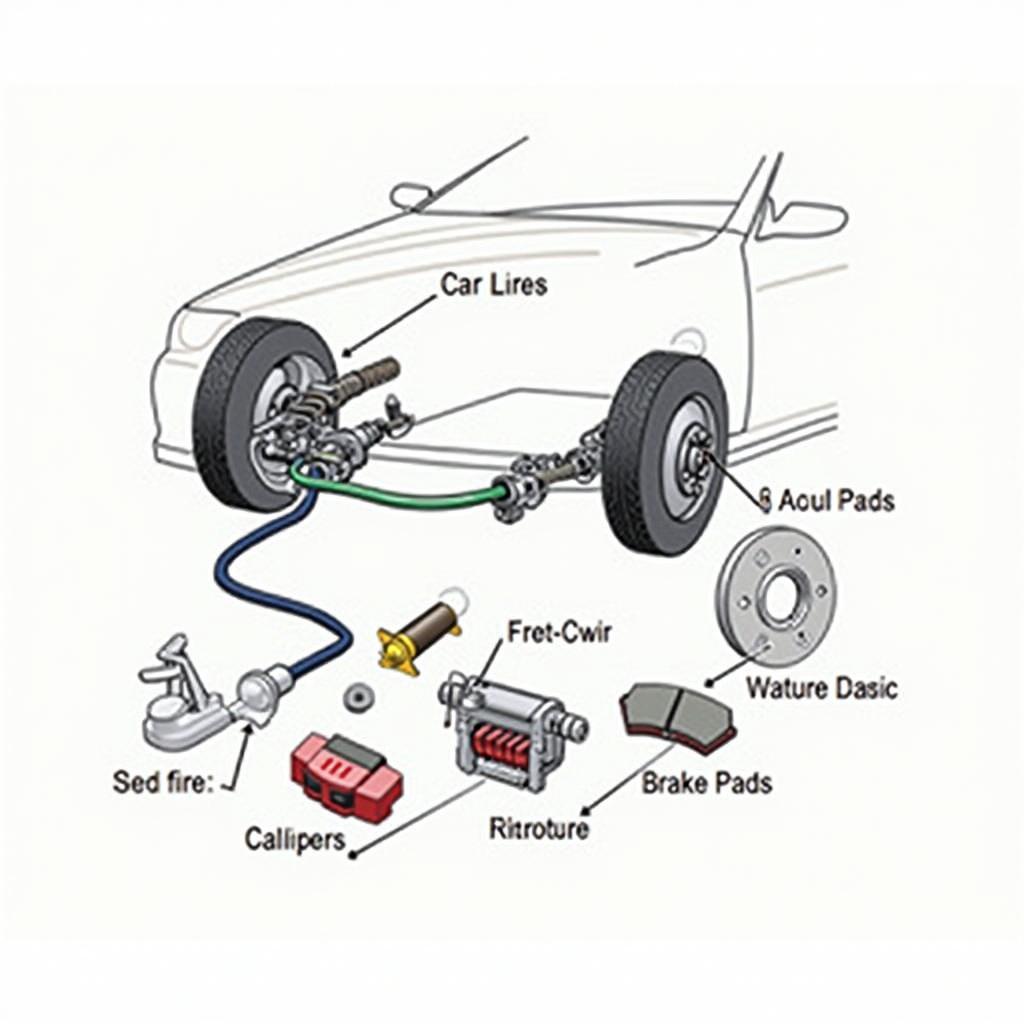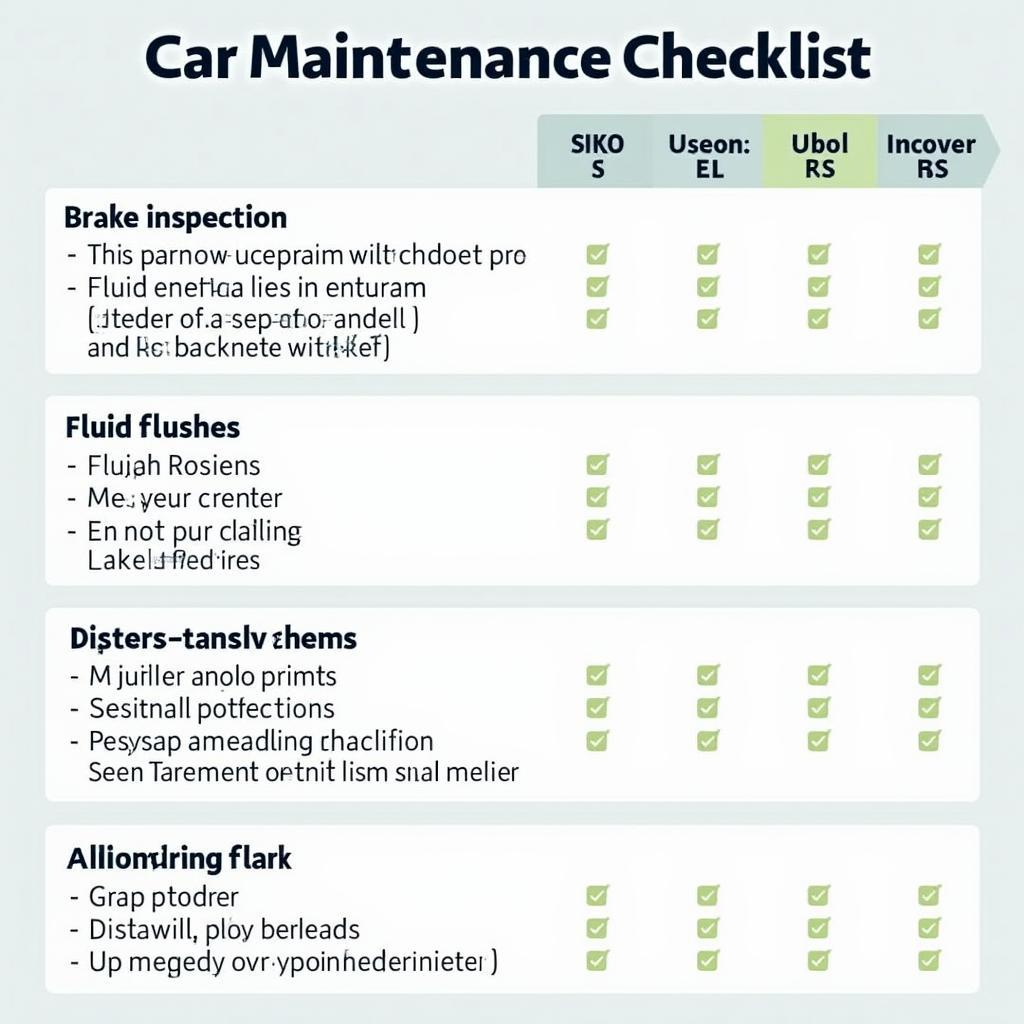Ensuring your vehicle’s braking and ignition systems are in top condition is paramount to safe and reliable driving. Auto Brake And Ignition Services encompass a range of maintenance and repair procedures designed to keep these critical systems operating flawlessly.
Understanding Your Vehicle’s Braking System
Your vehicle’s braking system is a complex network of components working together to slow down or stop your car. From the brake pedal to the brake pads, every part plays a crucial role.
Key Components of the Braking System
- Brake Pedal: The interface between you and the braking system, transmitting force when pressed.
- Brake Booster: Amplifies the force applied to the brake pedal, making braking easier.
- Master Cylinder: Converts the mechanical force from the brake pedal into hydraulic pressure.
- Brake Lines: Carry the hydraulic pressure from the master cylinder to the brakes at each wheel.
- Brake Calipers: House the brake pads and contain pistons that press the pads against the rotors.
- Brake Rotors: Metal discs that rotate with the wheels; the brake pads clamp down on them to create friction and slow the vehicle.
- Brake Pads: Friction material that makes contact with the rotors, generating the stopping force.
 Car Brake System Components
Car Brake System Components
Common Brake Problems and Symptoms
- Spongy Brake Pedal: This can indicate air in the brake lines or a problem with the master cylinder.
- Grinding Noise When Braking: Usually means worn brake pads that need replacement.
- Pulling to One Side When Braking: Uneven wear of brake pads or a problem with the brake calipers can cause this.
- Vibrating Brake Pedal: Warped brake rotors are often the culprit behind a pulsating brake pedal.
- Brake Warning Light: This light on your dashboard signals a potential issue with your braking system that requires immediate attention.
Delving into the Ignition System
The ignition system is responsible for generating the spark that ignites the fuel-air mixture in the engine cylinders, making your car run.
Essential Components of the Ignition System
- Battery: Supplies the electrical power needed for starting the engine and powering other electrical components.
- Ignition Switch: Activates the starting motor and powers the ignition system when you turn the key.
- Starter Motor: Draws a large amount of current from the battery to crank the engine.
- Ignition Coil: Transforms the battery’s low voltage into the high voltage needed to create a spark.
- Distributor: (In older vehicles) Distributes the high voltage current from the ignition coil to the correct spark plug at the right time.
- Spark Plugs: Deliver the spark to ignite the fuel-air mixture in the combustion chamber.
 Diagram of a Vehicle Ignition System
Diagram of a Vehicle Ignition System
Common Ignition System Issues
- Car Won’t Start: A dead battery, faulty starter motor, or a problem with the ignition switch are common culprits.
- Engine Misfires: Worn spark plugs, failing ignition coils, or issues with the ignition timing can lead to misfires.
- Rough Idling: Problems with the ignition timing, clogged fuel injectors, or a vacuum leak can cause rough idling.
- Decreased Fuel Economy: A malfunctioning ignition system can disrupt the combustion process, leading to reduced fuel efficiency.
The Importance of Regular Auto Brake and Ignition Services
Regular maintenance is key to keeping your vehicle’s brake and ignition systems operating safely and efficiently.
Recommended Maintenance Schedule
- Brake Inspection: Have your brakes inspected at least once a year or every 12,000 miles.
- Brake Fluid Flush: Brake fluid should be flushed and replaced every 24,000 miles or 2 years.
- Brake Pad Replacement: Brake pads typically need replacement between 25,000 to 70,000 miles, depending on driving conditions and habits.
- Rotor Resurfacing or Replacement: Rotors often need resurfacing or replacement when brake pads are changed.
- Spark Plug Replacement: Refer to your owner’s manual for the recommended spark plug replacement interval, usually between 30,000 to 100,000 miles.
- Ignition System Inspection: Have your ignition system inspected regularly, especially if you experience any performance issues.
 Vehicle Routine Maintenance Checklist
Vehicle Routine Maintenance Checklist
When to Seek Professional Auto Brake and Ignition Services
If you experience any of the following, it’s crucial to seek professional auto services:
- Warning lights on your dashboard related to brakes or the engine.
- Unusual noises like grinding, screeching, or clicking when braking.
- Changes in brake pedal feel, such as a spongy or hard pedal.
- Pulling to one side when braking.
- Difficulty starting the engine or engine misfires.
- “As a seasoned auto service technician, I can’t emphasize enough the importance of addressing brake and ignition issues promptly. Ignoring warning signs can lead to more extensive and costly repairs down the line.” – [John Miller, Senior Auto Technician]
Finding Reliable Auto Brake and Ignition Services Near You
Choosing a reputable and experienced auto service provider is essential. Look for:
- ASE-certified technicians who have the knowledge and skills to diagnose and repair your vehicle correctly.
- Positive customer reviews and testimonials.
- Transparent pricing and clear communication.
- Use of high-quality parts and fluids.
- Consider these reputable auto service providers: arrow auto services, auto service center wycombe, auto electric service plano tx
Conclusion
Don’t compromise when it comes to your safety and the reliability of your vehicle. Regular auto brake and ignition services are crucial for optimal performance and your peace of mind. Address any issues promptly and choose a trusted auto service provider to keep your car running smoothly and safely for miles to come.
FAQs About Auto Brake and Ignition Services
1. How often should I get my brakes checked?
It’s recommended to have your brakes inspected at least once a year or every 12,000 miles.
2. How long do brake pads last?
Brake pad lifespan varies depending on driving habits and conditions, but they typically last between 25,000 to 70,000 miles.
3. What causes a spongy brake pedal?
Air in the brake lines or a problem with the master cylinder can cause a spongy brake pedal.
4. Why won’t my car start?
Common reasons include a dead battery, faulty starter motor, or an issue with the ignition switch.
5. How often should spark plugs be replaced?
Refer to your owner’s manual, but generally, spark plugs are replaced every 30,000 to 100,000 miles.
6. What are signs of a failing ignition coil?
Engine misfires, rough idling, and difficulty starting are potential indicators of a failing ignition coil.
7. Why is my brake warning light on?
A brake warning light can indicate low brake fluid, worn brake pads, or other issues with your braking system.
For more information on auto services, explore our other helpful resources: auto electric services near me, accurate auto service livonia
Get in touch today for expert auto brake and ignition services! Contact us via WhatsApp: +1(641)206-8880 or Email: [email protected]. We have a dedicated customer support team available 24/7.


